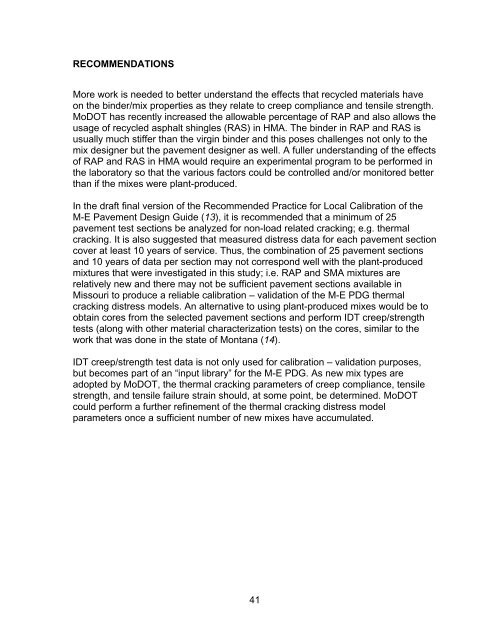RECOMMENDATIONSMore work is needed to better underst<strong>and</strong> the effects that recycled materials haveon the binder/mix properties as they relate to creep compliance <strong>and</strong> tensile strength.MoDOT has recently increased the allowable percentage <strong>of</strong> RAP <strong>and</strong> also allows theusage <strong>of</strong> recycled asphalt shingles (RAS) in HMA. The binder in RAP <strong>and</strong> RAS isusually much stiffer than the virgin binder <strong>and</strong> this poses challenges not only to themix designer but the pavement designer as well. A fuller underst<strong>and</strong>ing <strong>of</strong> the effects<strong>of</strong> RAP <strong>and</strong> RAS in HMA would require an experimental program to be performed inthe laboratory so that the various factors could be controlled <strong>and</strong>/or monitored betterthan if the mixes were plant-produced.In the draft final version <strong>of</strong> the Recommended Practice for Local Calibration <strong>of</strong> theM-E Pavement Design Guide (13), it is recommended that a minimum <strong>of</strong> 25pavement test sections be analyzed for non-load related cracking; e.g. thermalcracking. It is also suggested that measured distress data for each pavement sectioncover at least 10 years <strong>of</strong> service. Thus, the combination <strong>of</strong> 25 pavement sections<strong>and</strong> 10 years <strong>of</strong> data per section may not correspond well with the plant-producedmixtures that were investigated in this study; i.e. RAP <strong>and</strong> SMA mixtures arerelatively new <strong>and</strong> there may not be sufficient pavement sections available inMissouri to produce a reliable calibration – validation <strong>of</strong> the M-E PDG thermalcracking distress models. An alternative to using plant-produced mixes would be toobtain cores from the selected pavement sections <strong>and</strong> perform IDT creep/strengthtests (along with other material characterization tests) on the cores, similar to thework that was done in the state <strong>of</strong> Montana (14).IDT creep/strength test data is not only used for calibration – validation purposes,but becomes part <strong>of</strong> an “input library” for the M-E PDG. As new mix types areadopted by MoDOT, the thermal cracking parameters <strong>of</strong> creep compliance, tensilestrength, <strong>and</strong> tensile failure strain should, at some point, be determined. MoDOTcould perform a further refinement <strong>of</strong> the thermal cracking distress modelparameters once a sufficient number <strong>of</strong> new mixes have accumulated.41
REFERENCES1. Guide for Mechanistic-Empirical Design <strong>of</strong> New <strong>and</strong> Rehabilitated PavementStructures, Final National Cooperative Highway Research Program (NCHRP)Report 1-37A, S<strong>of</strong>tware version 1.003, Last Build May 24, 2007, website:http://www.trb.org/mepdg/ , Accessed March 5, 2008, Transportation ResearchBoard, National Research Council, Washington, D.C.2. Determining the <strong>Creep</strong> <strong>Compliance</strong> <strong>and</strong> <strong>Strength</strong> <strong>of</strong> <strong>Hot</strong>-<strong>Mix</strong> Asphalt (HMA)Using the Indirect <strong>Tensile</strong> Test Device, in AASHTO T 322-07. 2007, AmericanAssociation <strong>of</strong> State Highway <strong>and</strong> Transportation Officials, Washington, D.C.3. Determining the <strong>Creep</strong> <strong>Compliance</strong> <strong>and</strong> <strong>Strength</strong> <strong>of</strong> <strong>Hot</strong>-<strong>Mix</strong> Asphalt (HMA)Using the Indirect <strong>Tensile</strong> Test Device, in AASHTO T 322-03. 2003, AmericanAssociation <strong>of</strong> State Highway <strong>and</strong> Transportation Officials, Washington, D.C.4. Christensen, D. W., <strong>and</strong> R. F. Bonaquist. NCHRP Report 530: Evaluation <strong>of</strong>Indirect <strong>Tensile</strong> Test (IDT) Procedures for Low-Temperature Performance <strong>of</strong> <strong>Hot</strong><strong>Mix</strong> Asphalt. Transportation Research Board, National Research Council,Washington, D.C. 2004. website:http://onlinepubs.trb.org/onlinepubs/nchrp/nchrp_rpt_530.pdf. Accessed March 5,2008.5. Theoretical Maximum Specific Gravity <strong>and</strong> Density <strong>of</strong> <strong>Hot</strong>-<strong>Mix</strong> Asphalt Paving<strong>Mix</strong>tures, in AASHTO T 209-05. 2007, American Association <strong>of</strong> State Highway<strong>and</strong> Transportation Officials, Washington, D.C.6. St<strong>and</strong>ard Test Method for Bulk Specific Gravity <strong>and</strong> Density <strong>of</strong> CompactedBituminous <strong>Mix</strong>tures Using Automatic Vacuum Sealing Method, in ASTM D 6752-03e1. 2003, American Society for Testing <strong>and</strong> Materials. West Conshohocken,PA.7. Bulk Specific Gravity <strong>of</strong> Compacted <strong>Hot</strong>-<strong>Mix</strong> Asphalt <strong>Mix</strong>tures Using SaturatedSurface-Dry Specimens, in AASHTO T 166-07. 2007, American Association <strong>of</strong>State Highway <strong>and</strong> Transportation Officials, Washington, D.C.8. Guide for Mechanistic-Empirical Design <strong>of</strong> New <strong>and</strong> Rehabilitated PavementStructures, Final National Cooperative Highway Research Program (NCHRP)Report 1-37A, Appendix HH: Field Calibration <strong>of</strong> the Thermal Cracking Model,Transportation Research Board, National Research Council, Washington, D.C.December 2003.9. Buttlar, W. G., <strong>and</strong> R. Roque. Development <strong>and</strong> Evaluation <strong>of</strong> the StrategicHighway Research Program Measurement <strong>and</strong> Analysis System for Indirect<strong>Tensile</strong> Testing at Low Temperatures. In Transportation Research Record:Journal <strong>of</strong> the Transportation Research Board, No. 1454, TransportationResearch Board, National Research Council, Washington, D.C. 1994. pp. 163 –171.10. Chehab, G. R., <strong>and</strong> J. S. Daniel. Evaluating Recycled Asphalt Pavement<strong>Mix</strong>tures with Mechanistic-Empirical Pavement Design Guide Level 3 Analysis. InTransportation Research Record: Journal <strong>of</strong> the Transportation Research Board,No. 1962, Transportation Research Board, National Research Council,Washington, D.C. 2006. pp. 90 – 100.42
















